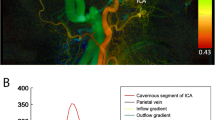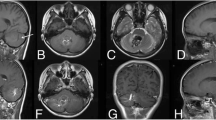Abstract
Purpose
To search for the risk factors closely related to cerebral cavernous malformation associated with developmental venous anomaly (CCM-DVA) lesions rupture, laying foundations for the development of reasonable individual treatment plans for patients.
Methods
In this retrospective study, we collected CCM-DVA patients who met the inclusion criteria in our outpatient department from 2014 to 2017, MRI scans were performed including susceptibility-weighted imaging (SWI) and contrast-enhanced imaging, characteristics and basic clinical information were collected then statistically analyzed, CCM-DVA lesions were divided into 3 types according to the location and quantitative relationship between CCM and DVA.
Results
A total number of 319 adult patients were identified with 41.2±11.9 years on average, though univariate and multivariate regression analysis, ruptured presentations were more common in patients with prior hemorrhage (p=0.003), type III CCM-DVA lesions (p=0.001), lesions volume>1 cm3 (p<0.001), infratentorial lesions especially located in midbrain (p=0.019), pontine (p=0.007), medulla (p=0.015). Caplan-Meier curve shows a lower Hemorrhage-free survival rate on patients with type III CCM-DVA lesions (log-rank, p=0.0222), functional area lesions (log-rank, p<0.001), lesions volume>1 cm3 (log-rank, p<0.001), infratentorial lesions (log-rank, p=0.0002).
Conclusion
The classification based on the relationship between CCM and DVA may be meaningful to predict the risk of lesion rupture and CCM lesions next to DVA distal branches showed a higher risk of rupture.



Similar content being viewed by others
References
McCormick WF (1984) Pathology of vascular malformations of the brain. In: Wilson CB, Stein BM (eds) Intracranial arteriovenous malformations. Williams & Wilkins, Baltimore, pp 44–63
Robinson JR, Awad IA, Little JR (1991) Natural history of the cavernous angioma. J Neurosurg 75(5):709–714
Salman AS, Hall JM, Horne MA et al (2012) Untreated clinical course of cerebral cavernous malformations: a prospective, population-based cohort study. Lancet Neurol 11(3):217–224
Flemming KD, Link MJ, Christianson TJH, Brown RD (2012) Prospective hemorrhage risk of intracerebral cavernous malformations. Neurology 78(9):632–636
Gross BA, Du R (2016) Hemorrhage from cerebral cavernous malformations: a systematic pooled analysis. J Neurosurg 126(4):1
Kondziolka D, Lunsford LD, Kestle JRW (1995) The natural history of cerebral cavernous malformations. J Neurosurg 83(5):820–824
Garner TB, Curling OD, Kelly DL, Laster DW (1991) The natural history of intracranial venous angiomas. J Neurosurg 75(5):715–722
Mclaughlin MR, Kondziolka D, Flickinger JC et al (1998) The prospective natural history of cerebral venous malformations. Neurosurgery 43(2):195–200
Roberson G (1974) Telangiectases and cavernous angiomas of the brainstem : “cryptic” vascular malformations. Neuroradiology 8:83–89
Clatterbuck RE, Rigamonti D (1999) A comparison of the clinical profile of cavernous malformations with and without associated venous malformations. Neurosurgery 44(1):46–47
Wurm G, Schnizer M, Nussbaumer K, Wies W, Holl K (2003) Recurrent cryptic vascular malformation associated with a developmental venous anomaly. Br J Neurosurg 17(2):188–195
Meng G, Bai C, Yu T, Wu Z, Liu X, Zhang J, zhao J (2014) The association between cerebral developmental venous anomaly and concomitant cavernous malformation: an observational study using magnetic resonance imaging. BMC Neurol 14(1):50
Perrini P, Lanzino G (2006) The association of venous developmental anomalies and cavernous malformations: pathophysiological, diagnostic, and surgical considerations. Neurosurg Focus 21(1):1–4
Ostertun B, Solymosi L (1993) Magnetic resonance angiography of cerebral developmental venous anomalies: its role in differential diagnosis. Neuroradiology 35(2):97–104
Aiba T, Tanaka R, Koike T, Kameyama S, Takeda N, Komata T (1995) Natural history of intracranial cavernous malformations. J Neurosurg 83(1):56–59
Moriarity JL, Wetzel M, Clatterbuck RE et al (1999) The natural history of cavernous malformations: a prospective study of 68 patients. Neurosurgery 44(6):1166–1173
Kashefiolasl S, Bruder M, Brawanski N, Herrmann E, Seifert V, Tritt S, Konczalla J (2018) A benchmark approach to hemorrhage risk management of cavernous malformations. Neurology 90:e856–e863
Barker FG, Amin-Hanjani S, Butler WE et al (2001) Temporal clustering of hemorrhages from untreated cavernous malformations of the central nervous system. Neurosurgery 49(1):15–25
Bertalanffy H (2002) Cerebral cavernomas in adult, review of the literature and analysis of 72 surgically treated patients. Neurosurg Rev 25:1–53
Marasco R, Spagnoli M, Leonardi M (2009) Association between developmental venous anomalies and cavernous angiomas: a retrospective MR study. Neuroradiol J 22(2):179–185
Kamezawa T, Hamada JI, Niiro M, Kai Y, Ishimaru K, Kuratsu JI (2005) Clinical implications of associated venous drainage in patients with cavernous malformation. J Neurosurg 102(1):24–28
Wurm G, Schnizer M, Fellner FA (2007) Cerebral cavernous malformations associated with venous anomalies. Neurosurgery 61(Supplement):SHC-390–SHC-406
Gross BA, Lin N, Du R et al (2011) The natural history of intracranial cavernous malformations. Neurosurg Focus 30(6):E24
Salman AS, Berg MJ, Morrison L et al (2008) Hemorrhage from cavernous malformations of the brain definition and reporting standards. Stroke 39(12):3222–3230
Young A, Poretti A, Bosemani T, Goel R, Huisman TAGM (2017) Sensitivity of susceptibility-weighted imaging in detecting developmental venous anomalies and associated cavernomas and microhemorrhages in children. Neuroradiology 59:797–802
Campeau NG, Lane JI (2005) De novo development of a lesion with the appearance of a cavernous malformation adjacent to an existing developmental venous anomaly. Am J Neuroradiol 26(1):156–159
Cakirer S (2003) De novo formation of a cavernous malformation of the brain in the presence of a developmental venous anomaly. Clin Radiol 58(3):0–256
Pereira VM, Geibprasert S, Krings T, Aurboonyawat T, Ozanne A, Toulgoat F, Pongpech S, Lasjaunias PL (2008) Pathomechanisms of symptomatic developmental venous anomalies. Stroke 39:3201–3215
Saito Y, Kobayashi N (1981) Cerebral venous angiomas: clinical evaluation and possible etiology. Radiology 139(1):87–94
Brinjikji W, Elmasri ER, Wald JT et al (2017) Prevalence of cerebral cavernous malformations associated with developmental venous anomalies increases with age. Childs Nerv Syst 33(9):1539–1543
Roccatagliata L, René van den Berg, Soderman M et al (2012) Developmental venous anomalies with capillary stain: a subgroup of symptomatic DVAs? Neuroradiology 54:475–480
Gross BA, Du R (2015) Cerebral cavernous malformations:natural history and clinical management. Expert Rev Neurother 15(7):771–777
Awad IA, Robinson JR, Mohanty S et al (1993) Mixed vascular malformations of the brain: clinical and pathogenetic considerations. Neurosurgery 33(2):179-88; discussion 188
Sharma A, Zipfel GJ, Hildebolt C, Derdeyn CP (2013) Hemodynamic effects of developmental venous anomalies with and without cavernous malformations. Am J Neuroradiol 34(9):1746–1751
Porter PJ, Willinsky RA, Harper W, Wallace MC (1997) Cerebral cavernous malformations: natural history and prognosis after clinical deterioration with or without hemorrhage. J Neurosurg 87(2):190–197
Petr O, Lanzino G (2015) Brainstem cavernous malformations. J Neurosurg Sci 59(3):271
Kupersmith MJ, Kalish H, Epstein F et al (2001) Natural history of brainstem cavernous malformations. Neurosurgery 49(4):1023–1024
Li D, Hao SY, Jia GJ, Wu Z, Zhang LW, Zhang JT (2014) Hemorrhage risks and functional outcomes of untreated brainstem cavernous malformations. J Neurosurg 121(1):32–41
Jeon JS, Kim JE, Chung YS, Oh S, Ahn JH, Cho WS, Son YJ, Bang JS, Kang HS, Sohn CH, Oh CW (2014) A risk factor analysis of prospective symptomatic haemorrhage in adult patients with cerebral cavernous malformation. J Neurol Neurosurg Psychiatry 85(12):1366–1370
Ruíz DS, Yilmaz H, Gailloud P (2010) Cerebral developmental venous anomalies: current concepts. Ann Neurol 66(3):271–283
Zhang P, Liu L, Cao Y, Wang S, Zhao J (2013) Cerebellar cavernous malformations with and without associated developmental venous anomalies. BMC Neurol 13(1):134–134
Im SH, Han MH, Kwon BJ, Ahn JY, Jung C, Park SH, Oh CW, Han DH (2008) Venous-predominant parenchymal arteriovenous malformation: a rare subtype with a venous drainage pattern mimicking developmental venous anomaly. J Neurosurg 108(6):1142–1147
Hong YJ, Chung TS, Suh SH, Park CH, Tomar G, Seo KD, Kim KS, Park IK (2010) The angioarchitectural factors of the cerebral developmental venous anomaly; can they be the causes of concurrent sporadic cavernous malformation? Neuroradiology 52(10):883–891
Funding
This study was funded by the National Natural Science Foundation of China (81371292) and the National Natural Science Foundation of China (H0906 81801140).
Author information
Authors and Affiliations
Corresponding author
Ethics declarations
Conflict of interest
The authors declare that they have no conflict of interest.
Ethical approval
For this type of study formal consent is not required.
Informed consent
Informed consent was obtained from all individual participants included in the study.
Additional information
Publisher’s note
Springer Nature remains neutral with regard to jurisdictional claims in published maps and institutional affiliations.
Rights and permissions
About this article
Cite this article
Zhang, S., Ma, L., Wu, C. et al. A rupture risk analysis of cerebral cavernous malformation associated with developmental venous anomaly using susceptibility-weighted imaging. Neuroradiology 62, 39–47 (2020). https://doi.org/10.1007/s00234-019-02274-1
Received:
Accepted:
Published:
Issue Date:
DOI: https://doi.org/10.1007/s00234-019-02274-1




